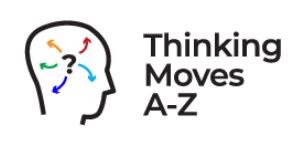
Why use Thinking Moves?
“Stunningly simple, yet remarkably rich.”
Thinking Moves A-Z is the easiest way to embed metacognition in all subjects, at every level.
It’s a framework for focussing on the thinking that is being done – or should be done – in class, but also in everyday life.
Even young children can learn it and use it to manage their thinking – and their behaviour – more effectively.
It has this extraordinary capacity because it uses common vocabulary to present the 26 acts that are fundamental to human thought, in a sort of “periodic table”.
“You have to work hard to get your thinking clean to make it simple. But it’s worth it in the end because once you get there, you can move mountains.” - Steve Jobs.
All of the thinking processes listed in Bloom’s taxonomy are encompassed within the simpler scheme of Thinking Moves A – Z.
Easy to understand, remember and apply. The most comprehensive scheme possible.
Why use any other?
Research by the Education Endowment Foundation has shown that effective strategies for metacognition and self-regulation:
are very high impact for very low cost based on extensive evidence
can be worth the equivalent of an additional +7 months’ progress when used well
can motivate pupils to engage in, and improve, their learning.
can be particularly effective for low achieving and disadvantaged pupils.
Thinking Moves A – Z supports every step of the EEF’s recommended framework for metacognition and self-regulated learning.
The Thinking Moves scheme has been 10 years in the making. You can use it immediately to improve teaching and learning by giving students a common vocabulary to “think out loud.”
It enables rich conversations about thinking and gives both teachers and learners an array of truly metacognitive strategies that can be used autonomously.
Why is metacognition important?
“This pocket-sized curriculum for an age in crisis deserves to play a prominent role in any school…
…and education system for which the penny’s finally dropped – that the old practices and ambitions are no longer fit for purpose and do not equip our children to thrive – or perhaps not even to survive – in a world which requires us urgently to behave as humans at their best can and must – reasonably, critically, and wisely. It’s a cliche to say that a book deserves to do well. Heaven knows, this one needs to.”
Prof. Barry Hymer
Emeritus Professor of Psychology in Education, University of Cumbria, England
Resources
Download classroom-ready resources for all subjects and age groups
Training
Make an immediate difference to teaching with our in-school training programme
Shop
Buy the book, as well as other classroom essentials (opens to The Philosophy Man website)
“For our students, many of whom need time to process, using Thinking Moves has allowed them to build in the necessary processing time to support their thinking; thus, building confidence in oracy.”
Using Thinking Moves through enquiry has had a positive effect on developing students’ comprehension skills by allowing them the opportunity to talk collaboratively in a focussed, facilitated way. Giving the Thinking Moves prominence ensured the discussion remained purposeful and that learning was taking place; there was progression both in terms of language acquisition and comprehension, and thinking skills.
Judith Stephenson
Lead Practioner, Barbara Priestman Academy, fom the Action Research case study completed as part of the Department for Education (DfE, UK) Nasen Universal SEND programme.
Do you know your A-Z?
“(It’s) doing exactly what it is designed to do and provides a common language for learning… large amounts of repeated explanation are now unnecessary, meaning more time can be spent on new ideas and learning.”
“Once the initial discussion and development of a move reaches a critical point, it becomes a core concept, the young people don’t need to discuss it or have it explained, they can now simply use the word ‘test’ as it already carries all the vocabulary and understanding we have worked on. At this point, a Thinking Move is doing exactly what it is designed to do and provides a common language for learning.
When we say order, everyone knows exactly what we mean; large amounts of repeated explanation are now unnecessary, meaning more time can be spent on new ideas and learning.
Ian Burke
Science Lead
From the Action Research case study completed as part of the Department for Education (DfE, UK) nasen Universal SEND programme.
“We have seen tremendous growth in our students’ ability to explain and evaluate their own thinking.”
“Teachers have expressed their enjoyment incorporating the Thinking moves in their classes. They have remarked about how easily they can be embedded into any topic and how students are now able to use them naturally and without prompting. New teachers to our school are always very impressed at how well the students can remember them and how the students are able to continue using them over the span of their primary school journey.”
Vanessa Dewey
Primary school teacher
Contact us
Whether you'd like to invite us to train staff, work with pupils, or something else entirely, we'd love to hear from you.
Send us a message!








